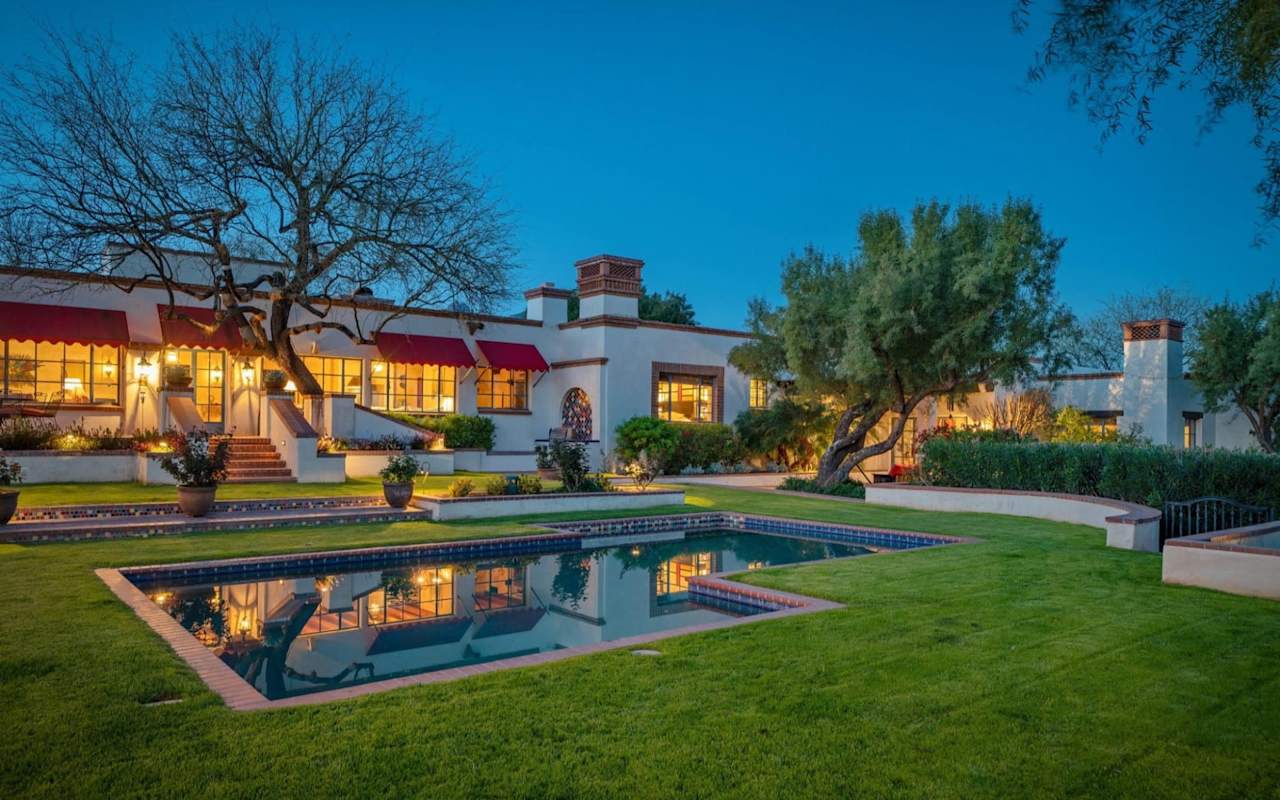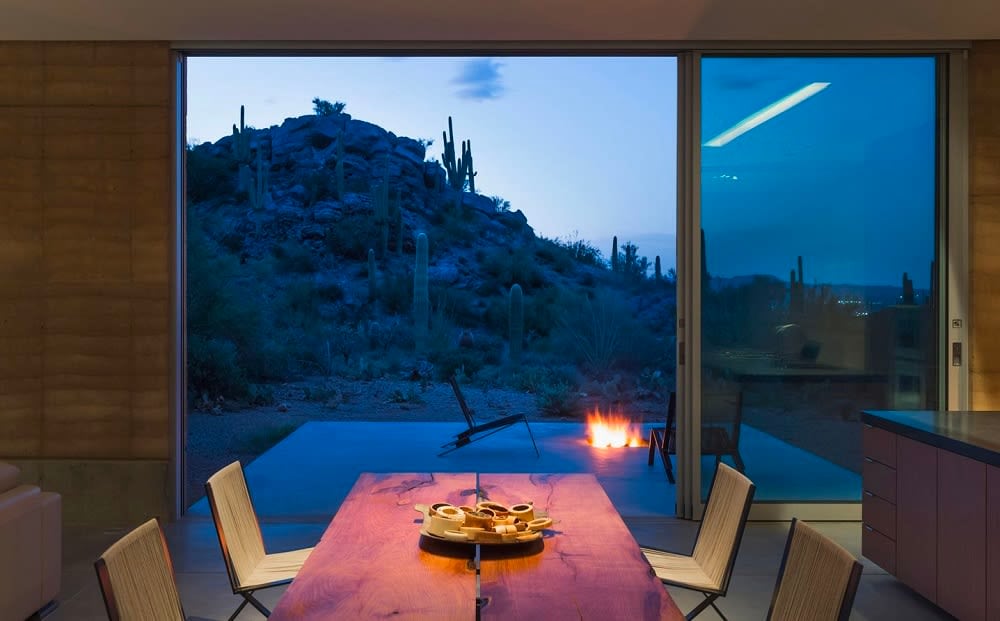If you’ve traveled throughout the southwestern region of the United States, you’ve likely come across unique homes made out of mud adobe bricks. Adobe was initially used prehistorically in today’s American Southwest and select regions worldwide. Today, architects achieve the adobe aesthetic with traditional mud brick, rammed earth, straw bales, and other desert-friendly materials.
These timeless materials fit the demands of the moment, with more luxury buyers preferring genuine adobe as an alternative to wood-framed houses with faux adobe finishes. An investment and a lifestyle, these earthy, minimalistic homes beautifully marry form with function. Read on to learn more about the adobe style and a few case studies relevant to Arizona and the Tucson real estate market.
Overview of the adobe aesthetic
Walk into any modern adobe house, and you’ll soon forget it was built in the last 20 years. Many of these homes are one-off private builds planned and executed by excellent local design and architecture studios. By no means interchangeable, many such homes nonetheless share elements of form, function, and sustainability.
Form
As an architectural style, adobe brick houses are easily recognizable with their thick walls and rounded corners. The rounded corners make the home appear softer and more organic. Designs typically start with warm, earthy colors (like terra cotta, desert sand, and adobe pink) that blend in naturally with the surrounding landscape.
Homes include various overhangs or shading devices that protect you from heat and direct sun. Structural quirks of adobe homes include exposed wooden beams (also called vigas) and small branches or sticks in the roofing material (referred to as latillas).
Function
Historically, adobe structures were favored for churches and public buildings throughout the American Southwest. Because of their prominence, adobe homes came to be associated with the history and culture of Arizona and New Mexico. Over time, more people are discovering the benefits of a material that insulates well, resists moisture, and is fireproof.
They also reflect greater attention to outdoor living. It’s common for these homes to have a central courtyard or patio. Shared space is often the heart of the house and can be used for entertaining guests or spending time outside.
Sustainability
Sustainability is a crucial point in favor of the adobe aesthetic. Some adobe brick homes use primarily natural materials such as locally sourced soil. The bricks are pest resistant and do not quickly rot, so adobe homes often don’t require the same maintenance as you might expect from another property. If you own an adobe brick house, you’ll likely spend little time dealing with extra repairs or painting.
Despite high entry costs, adobe builds favor homeowners with an insulation system uniquely suited to the desert climate. The walls protect residents from hot days, and the bricks cool overnight. Standard adobe bricks are 16” wide, and often adobe walls are reinforced with concrete for additional protection from the weather. Flat roofs help keep the home cooler, as do overhangs or other shading appurtenances.
Case studies: Community builds
Adobe has been featured in community builds dating back several millennia. In recent years, a handful of neighborhood-sized projects have helped put adobe back in the conversation.
Adobes at Sky Ranch
Occupying over 500 acres near Dove Mountain, the
Adobes at Sky Ranch stand out as an ambitious modern building project built mainly from adobe. The community expertly balances environmental soundness with economic viability.
The project’s scope and attention to detail are immediately apparent. Hundreds of acres of undisturbed open space and natural vegetation adjoin each home. Stellar Gray, the developers of Sky Ranch, chose to limit construction to 20% of the community’s total landmass. As a result, species like pygmy owls have thrived in harmony with Sky Ranch houses.
As you enter these adobe homes, you are transfixed by their features. Wood viga beamed ceilings and integral colored mud harmonize in rustic elegance. The rhythms of the surrounding nature gradually sink in, with sounds half-muted by 16”-thick brick adobe walls.
Adobes del Bosque
Also completed by the developers at Stellar Gray,
Adobes del Bosque is another excellent example of harmony with nature. The homes are secondary to the ecological achievement of this development. When the developer purchased the land, many of the forest’s trees had been cleared or died because of decreased water supply. In total, about 1,200 of the bosque’s 1,400 trees were preserved.
For such a niche build, adobes are surprisingly versatile, with many homes incorporating design elements from places diverse as Mexico, India, and Morocco. These styles share minimalistic principles that shape the bones of the house. Rooms tend to flow outdoors into patios. Sheltered corners are ideal for windy days or nights; the silent mud walls speak volumes.
Case studies: Individual builds
Besides a handful of community projects, it’s common for agencies to complete one-off projects. Because adobes are lucrative, local developers and construction companies can stay solvent with only a handful of adobes per year. Meanwhile, Tucson is an under-the-radar hub for architecture, with the renowned
Studio Rick Joy working internationally.
Mountain retreats
Photo courtesy of DUST
Arizona’s desert mountains lend themselves to contemplation and reflection. The Tucson design studio DUST completed
this mountain retreat in the summer of 2012 for a couple whose dream was “reconnecting their roots to this magical and mysterious landscape.” Instead of adobe, the home’s core structure is built from rammed earth. DUST infused the house with accents like fragrant Spanish cedar in bedrooms, charred bathroom walls, and dappled light filters.
Off-grid houses
DUST built
this home for a client who wanted an “off-grid house that could celebrate its place in the remote landscape.” Rather than adobe or rammed earth, this home features walls made of pulverized red scoria and cement. In keeping with its minimal style, the house features a straightforward floor plan with the kitchen, dining, and living rooms linked by the
zaguan (a wide central hallway).
Looking for an adobe house in Tucson?
You can count on the
Gray | St. Onge real estate team to help you with your upcoming sale or purchase. They rank in the top 1% of agents nationwide, bringing 25 combined years of experience to the table. The team has gained a reputation in the Tucson real estate market by building trust with each client and successfully guiding them throughout the real estate process.
Are you intrigued by
adobe homes or the fast-growing Tucson? Contact the office if you’re looking for help buying or selling Tucson luxury homes, and they will be glad to assist you.











